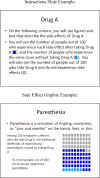Using a graphical risk tool to examine willingness to take migraine prophylactic medications
- PMID: 27820159
- PMCID: PMC5433431
- DOI: 10.1097/j.pain.0000000000000630
Using a graphical risk tool to examine willingness to take migraine prophylactic medications
Abstract
Many migraine sufferers use daily prophylactic therapy to reduce the frequency of their headache attacks. The Food and Drug Administration has approved several different medications for migraine prophylaxis, but it is not clear whether sufferers perceive these treatments to provide clinically significant benefits given their side effect profiles. Three hundred headache sufferers were recruited from the community and local headache clinics using print and television advertising. Participants reported experiencing problematic headache attacks with a median (IQR) frequency of 7.0 (4-13) headache days per month. These sufferers participated in a cross-sectional, single-site, study that used a specially designed computer assessment task. Participants were instructed on the probability of experiencing the 3 most commonly experienced side effects for several blinded medication profiles: divalproex sodium, venlafaxine, gabapentin, propranolol, and topiramate. After learning the likelihood of experiencing side effect profiles of each medication, participants were asked whether they would be willing to take the medication for a given headache reduction level, which ranged from 0 to 7 days per month. The side effect profile for divalproex sodium was associated with the smallest willingness to take, with gabapentin, propranolol, and topiramate perceived to be much more agreeable. However, <60% of participants reported willingness to take any of these medications even if they provided a 50% reduction in headache frequency. Several general predictors of willingness to take were observed including high headache-related disability, depressive symptoms, and pain medication concerns including fear of tolerance. These findings suggest that if properly informed of the side effect profiles of these medications, many patients might opt for other treatments.
Conflict of interest statement
Conflicts of Interest: D. P. Turner and A. N. Golding have no conflicts to report. T. T. Houle was a consultant for Depomed, Inc. during the time period prior to submission.
Figures



References
-
- Austin PC. Using the standardized difference to compare the prevalence of a binary variable between two groups in observational research. Communications in Statistics-Simulation and Computation. 2009;38:1228–1234.
-
- Brantley PJ, Bodenlos JS, Cowles M, Whitehead D, Ancona M, Jones GN. Development and Validation of the Weekly Stress Inventory-Short Form. Journal of Psychopathology and Behavioral Assessment. 2007;29:54–59.
-
- Bussone G, Diener HC, Pfeil J, Schwalen S. Topiramate 100 mg/day in migraine prevention: a pooled analysis of double blind randomised controlled trials. International Journal of Clinical Practice. 2005;59:961–968. - PubMed
Publication types
MeSH terms
Substances
Grants and funding
LinkOut - more resources
Full Text Sources
Other Literature Sources
Medical

